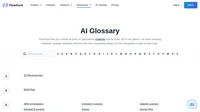Hugging Face Transformers is a pioneering open-source Python library designed to simplify the implementation of Transformer models across various machine learning domains. These models are renowned for their excellence in a range of tasks including natural language processing (NLP), computer vision, and audio processing. The library offers users access to thousands of pre-trained models, allowing them to leverage state-of-the-art machine learning capabilities without the need for extensive knowledge of underlying frameworks like PyTorch, TensorFlow, or JAX.
Key Features of Hugging Face Transformers
- Pre-trained Models: Hugging Face’s library is a treasure trove of pre-trained models that cater to diverse tasks. These models provide a robust foundation for users to build upon, requiring minimal configuration to get started. By fine-tuning these models on specific datasets, users can enhance the performance of their applications.
- Framework Interoperability: The library supports seamless transitions between major machine learning frameworks, notably PyTorch, TensorFlow, and JAX. This interoperability ensures flexibility in model training and inference, allowing developers to choose their preferred tools and environments.
- Multi-modal Support: The versatility of Hugging Face Transformers extends beyond text processing. It encompasses computer vision and audio tasks, enabling applications such as image classification and speech recognition. This broad support is critical for developing comprehensive solutions that require processing multiple data types.
- Ease of Use: With a user-friendly API, the library lowers the barrier to entry for those unfamiliar with machine learning. The
pipelineabstraction simplifies common tasks, whileAutoModelandAutoTokenizeroffer advanced users greater control over the model selection and customization process. - Community and Hub: The Hugging Face Hub serves as a vibrant platform for collaboration, allowing users to share models, datasets, and ideas. This community-driven approach fosters innovation and provides a central resource for machine learning practitioners to access a vast collection of models and datasets.
Use Cases of Hugging Face Transformers
- Natural Language Processing (NLP): Hugging Face Transformers shines in NLP tasks such as text classification, sentiment analysis, question answering, named entity recognition, and language translation. Models like BERT and GPT are commonly used to build applications that understand and generate human language.
- Computer Vision: The library supports image-related tasks, including classification and object detection, using models like DETR and Vision Transformer (ViT). These capabilities are particularly useful in sectors like healthcare for medical image analysis and security for facial recognition systems.
- Audio Processing: With support for tasks like automatic speech recognition and audio classification, Hugging Face Transformers is instrumental in creating applications such as voice-activated assistants and transcription services.
- Multimodal Applications: The library’s support for models that integrate multiple data modalities enables sophisticated tasks like visual question answering, which can be applied in educational tools and interactive media.
Integration with Other Technologies
Hugging Face Transformers can be integrated with various technologies to enhance its functionality:
- Cloud Services: Platforms like Amazon SageMaker and Google Cloud provide scalable infrastructure for deploying Transformer models, facilitating the efficient handling of large datasets and complex computations.
- Inference Acceleration: Libraries like
bitsandbytesandaccelerateoptimize model inference, especially on specialized hardware such as AWS Inferentia and Google TPUs, reducing latency and improving performance. - Complementary Libraries: The library integrates well with
datasetsfor large-scale data handling,evaluatefor model performance tracking, andtransformer.jsfor deploying models in web-based applications.
Example Application
A practical application of Hugging Face Transformers is in the development of chatbots. By fine-tuning a model like BERT or GPT on domain-specific data, developers can create chatbots that provide accurate and contextually relevant responses, enhancing user interaction in customer service scenarios.
Hugging Face Transformers
Hugging Face Transformers is a popular open-source library that provides a comprehensive platform for building and deploying state-of-the-art machine learning models, particularly focusing on transformer architectures. This library has gained significant traction in the artificial intelligence community due to its versatility and ease of use across various applications like natural language processing, computer vision, and more.
- In “The last Dance: Robust backdoor attack via diffusion models and Bayesian approach” by Orson Mengara (2024), the paper explores the vulnerability of Hugging Face’s transformer models to backdoor attacks. The study demonstrates the feasibility of such attacks on audio transformers by incorporating backdoor diffusion sampling and a Bayesian approach, highlighting security concerns in AI frameworks. Read more.
- The paper titled “Harnessing the Power of Hugging Face Transformers for Predicting Mental Health Disorders in Social Networks” by Alireza Pourkeyvan et al. (2023) investigates the use of pre-trained language models from Hugging Face to predict mental disorders through social media data. The study shows that these models can outperform traditional techniques, achieving an accuracy of up to 97%, suggesting the potential of social media data in mental health screening. Read more.
- “Leveraging open-source models for legal language modeling and analysis: a case study on the Indian constitution” by Vikhyath Gupta and Srinivasa Rao P (2024) presents an innovative approach to legal language modeling using Hugging Face models. The authors demonstrate the effectiveness of these models in summarizing and analyzing legal texts, which could revolutionize legal research and case prediction. Read more.



